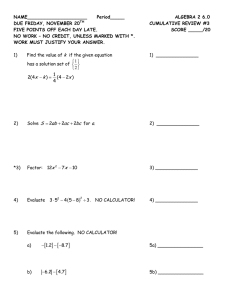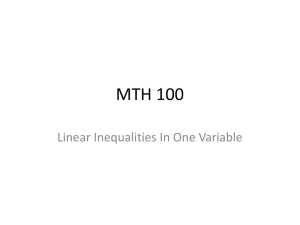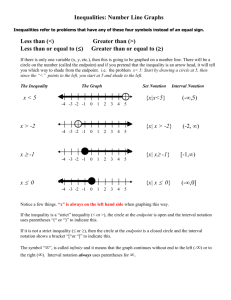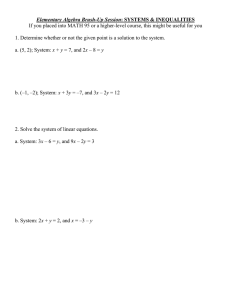Quiz Solutions: Linear Systems, Inequalities, Geometry
advertisement
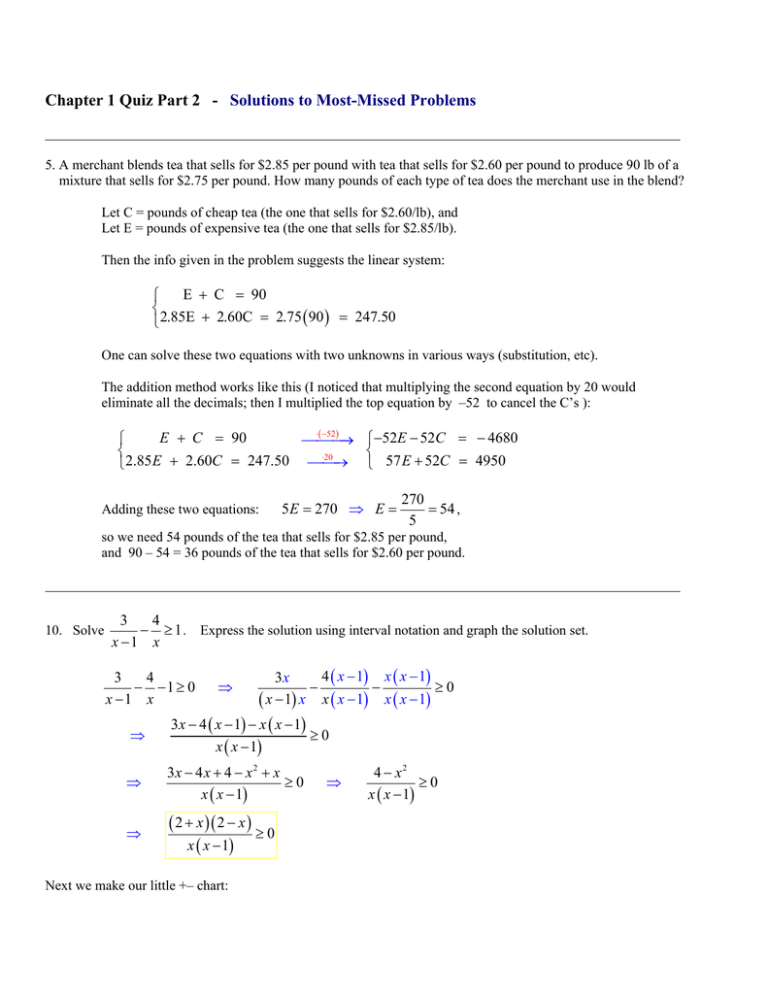
Chapter 1 Quiz Part 2 - Solutions to Most-Missed Problems ____________________________________________________________________________________________ 5. A merchant blends tea that sells for $2.85 per pound with tea that sells for $2.60 per pound to produce 90 lb of a mixture that sells for $2.75 per pound. How many pounds of each type of tea does the merchant use in the blend? Let C = pounds of cheap tea (the one that sells for $2.60/lb), and Let E = pounds of expensive tea (the one that sells for $2.85/lb). Then the info given in the problem suggests the linear system: E + C = 90 ⎧ ⎨ ⎩2.85E + 2.60C = 2.75 ( 90 ) = 247.50 One can solve these two equations with two unknowns in various ways (substitution, etc). The addition method works like this (I noticed that multiplying the second equation by 20 would eliminate all the decimals; then I multiplied the top equation by –52 to cancel the C’s ): ⋅( −52 ) E + C = 90 ⎧ → ⎧−52E − 52C = − 4680 ⎯⎯⎯ ⎨ ⎨ ⋅20 ⎩2.85 E + 2.60C = 247.50 ⎯⎯→ ⎩ 57 E + 52C = 4950 Adding these two equations: 5E = 270 ⇒ E = 270 = 54 , 5 so we need 54 pounds of the tea that sells for $2.85 per pound, and 90 – 54 = 36 pounds of the tea that sells for $2.60 per pound. ____________________________________________________________________________________________ 10. Solve 3 4 − ≥ 1 . Express the solution using interval notation and graph the solution set. x −1 x 3 4 − −1 ≥ 0 x −1 x ⇒ 4 ( x − 1) x ( x − 1) 3x − − ≥0 ( x − 1) x x ( x − 1) x ( x − 1) ⇒ 3 x − 4 ( x − 1) − x ( x − 1) ≥0 x ( x − 1) ⇒ 3x − 4 x + 4 − x 2 + x ≥0 x ( x − 1) ⇒ ( 2 + x )( 2 − x ) ≥ 0 x ( x − 1) Next we make our little +– chart: ⇒ 4 − x2 ≥0 x ( x − 1) Q= Notice that we are looking at where where Q is + and where Q is 0. ( 2 + x )( 2 − x ) ≥ 0 x ( x − 1) , i.e., we are looking in the above chart for Thus the solution set for our nonlinear inequality Q, is [ −2, 0 ) ∪ (1, 2] . ____________________________________________________________________________________________ 13. Solve the inequality 5 x + 24 < 9 . 5 x + 24 < 9 ⇒ 5 x < −15 ⇒ Express the solution using interval notation. x < −3 Thus the solution is all x in the interval ( −∞, −3) . ____________________________________________________________________________________________ 14. In the vicinity of a bonfire, the temperature T in T= 762500 . x 2 + 300 at a distance of x meters from the center of the fire was given by At what range of distances from the fire's center was the temperature less than We’ll solve the inequality, 500 > 762500 . x 2 + 300 C? Notice that the denominator is ALWAYS positive. So we can ( ) multiply both sides by this denominator, thus obtaining 500 x 2 + 300 > 762500 . Dividing both sides by 500 yields: x + 300 > 1525 , and then subtracting 300 from both sides results in x 2 > 1225 . Taking the square root of both sides, realizing that x must be positive, we get: x > 35 . 2 Points more than 35 meters away from the fire will be less than C. ____________________________________________________________________________________________ 15. Solve the inequality 20 − 4 x ≤ −16 . Express the solution using interval notation. 20 − 4 x ≤ −16 ⇒ − 4 x ≤ −36 This solution set is the interval [9, ∞ ) ⇒ −4 x −36 ≥ −4 −4 ⇒ x≥9 . ____________________________________________________________________________________________ x > 3x . Express the solution using interval notation and graph the solution set. x +1 17. Solve the nonlinear inequality x > 3x x +1 ⇒ ⇒ x − 3x > 0 x +1 x − 3x 2 − 3x >0 x +1 ⇒ ⇒ 3x ( x + 1) x − >0 x + 1 ( x + 1) −3 x 2 − 2 x >0 x +1 ⇒ ⇒ x − 3 x ( x + 1) >0 x +1 − x ( 3x + 2 ) >0 x +1 Next we make our little +– chart: Notice that we are looking at where where Q is +. Q= − x ( 3x + 2 ) >0 x +1 , i.e., we are looking in the above chart for Thus the solution set for our nonlinear inequality Q, is ( −∞, −1) ∪ ⎛⎜ − 2 ⎞ ,0⎟ ⎝ 3 ⎠. ____________________________________________________________________________________________ 18. Solve the inequality 5 x + 2 + 9 > 8 . Express the answer using interval notation. 5 x+2 +9 >8 ⇒ 5 x + 2 > −1 Notice that the left side of the equal sign is positive (or zero), which thus HAS to be larger than negative one. Thus, any real value for x will result in the inequality being true. The solution set is thus all real numbers, which in interval notation is written as ( −∞, ∞ ) ____________________________________________________________________________________________ 19. Express the phrase “All real numbers x at least 3 units from 4 “ as an inequality involving an absolute value. We seek all real numbers x that are at a distance of 3 or more units from 4, or in other words, the distance from x to 4 is greater than or equal to 3: x−4 ≥3 ( Remember that the distance from A to B is given by | A - B | . ) ____________________________________________________________________________________________ 1 20. Determine the values of the variable for which the expression 1 ⎞2 ⎛ ⎟ is defined as a real number. ⎜ 2 ⎝ x − x − 20 ⎠ To be a real number, the denominator must be positive (that ½ power means the same as “square root”): 0 < x 2 − x − 20 0 < ( x + 4 )( x − 5 ) = Product Making our little +- chart: x+4 – x–5 – Product + 0 + 0 + – 0 + – 0 + –4 5 1 1 ⎛ ⎞2 So ⎜ 2 ⎟ is defined as a real number whenever that product is positive, on the set: ⎝ x − x − 20 ⎠ ( −∞, −4 ) ∪ ( 5, ∞ ) ____________________________________________________________________________________________ 23. Find a point on the y-axis that is equidistant from the points (1, –7) and (5, –1). Points on the y-axis are all of the form (0, y), and so we seek a y such that The distance from (1, –7) to (0, y), is equal to the distance from (5, –1) to (0, y). It’s easier to square both sides to eliminate the square roots ; (1 − 0 ) + ( −7 − y ) 2 2 = ( 5 − 0 ) + ( −1 − y ) 2 2 1 + 49 + 14 y + y 2 = 25 + 1 + 2 y + y 2 50 + 14 y = 26 + 2 y 12 y = −24 ⇒ y = −2 ____________________________________________________________________________________________ 26. Find the area of the region that lies outside of the circle decimal places. but inside of the circle The first equation can be written x 2 + y 2 = 32 , the circle centered at the origin with radius 3. to two Next lets find the standard form equation for the second circle: x 2 + y 2 − 2 y + 1 = 48 + 1 ( x2 + y − 1 ) 2 = 49 x 2 + ( y − 1) = 7 2 2 So this is the circle centered at the point (0, 1) with radius 7. Notice that the first smaller circle is entirely within the larger circle, so the area we want is simply: circle "area of big circle" – "area of small circle" = π ⋅ 7 2 − π ⋅ 32 = 49π − 9π = 40π Rounding off to the hundredth place, we get: 40π 125.66370614359172954 ≅ 125.66 ____________________________________________________________________________________________ 27. A city has streets that run north and south, and avenues that run east and west, all equally spaced. Streets and avenues are numbered sequentially, as shown in the figure. Find the walking distance and the straight-line distance between the corner of 4th St. and 2nd Ave. and the corner of 9th St. and 14th Ave. In other words, find the distance between the point (4, 2) and the point (9, 14): Distance = ( 9 − 4 ) + (14 − 2 ) 2 2 = 52 + 122 = 25 + 144 = 169 = 13 ____________________________________________________________________________________________ 32. Determine the correct equation for the line passing through the point (1, 17) and the point (13, 4). First we find the slope: m= y2 − y1 4 − 17 13 = = − 12 x2 − x1 13 − 1 y = mx + b = − So our line is of the form, 13 ⋅ x + b , and we need to find b. But we know the 12 line goes through the point (1, 17), which means when x=1 then we have y=17. Substituting into our last equation, we can solve for b: y=− 13 ⋅x+b 12 ⇒ 17 = − 13 ⋅1 + b 12 Thus, in slope-intercept form our line’s equation is 13 =b 12 ⇒ b= 217 12 ⇒ 17 + y=− 13 217 ⋅x+ . To get this line into 12 12 same form as the answer selections given, multiply both sides by 12, and get everything on the same side of the equal sign: 12 y = −13x + 217 ⇒ 13 x + 12 y − 217 = 0 ____________________________________________________________________________________________ 33. Determine the correct equation for the line with an x-intercept of –1 and y-intercept 8. Our line goes through the points (-1, 0) and (0, 8). The slope is thus: m= y2 − y1 8−0 8 = = = 8 x2 − x1 0 − ( −1) 1 We are told the y-intercept is 8. So, the slope-intercept equation for this line is: y = mx + b ⇒ y = 8x + 8 ____________________________________________________________________________________________ 36. Determine the equation that expresses A is proportional to G and inversely proportional to z. Symbols a, b, and c are constants. A= kG is an equation expressing this proportionality, with k as the constant of proportionality. z This may also be written as G . If we replace the constant k with one of the constants z G A = c⋅ z A=k⋅ given in the problem, it becomes: ____________________________________________________________________________________________ 37. Express the statement as a formula: “s is inversely proportional to the square root of t”. Use the information that if s = 2 then t = 64 to find the constant of proportionality. s= k t ⇒ 2= k 64 ⇒ 2= k 8 ⇒ 16 = k ____________________________________________________________________________________________ 38. The resistance R of a wire varies directly as its length L and inversely as the square of its diameter d. Find the constant of proportionality K if a wire 63.7 m long and 0.007 m in diameter has a resistance of 91 ohms. Find the resistance R1 of a wire made of the same material that is 1 m long and has a diameter of 0.002 m. kL R= 2 d R= ⇒ 0.00007 L d2 91 = ⇒ k ⋅ 63.7 ⇒ 91( 0.007 ) k= 63.7 ( 0.007 ) ( 0.00007 ) ⋅1 R1 = 2 ( 0.002 ) 2 ⇒ 2 ⇒ k = 0.00007 R1 = 17.5 Ω ( Note: Ω is the symbol (a Greek letter) used to represent ohms. ) ____________________________________________________________________________________________ 39. In the short growing season of the Canadian arctic territory of Nunavut, some gardeners find it possible to grow gigantic cabbages in the midnight sun. Assume that the final size of a cabbage is proportional to the amount of nutrients it receives, and inversely proportional to the number of other cabbages surrounding it. A cabbage that received 20 oz of nutrients and had 6 other cabbages around it grew to 27 lb. What size would it grow to if it received 10 oz of nutrients and had only 3 cabbage neighbors? Let S be the final cabbage size, and let N be the amount of nutrients it receives, and let C be the number of neighboring cabbages. Then we are told that: 27 ( 6 ) 81 kN k ⋅ 20 ⇒ 27 = ⇒ k= = 6 20 10 C 8.1(10 ) 81 8.1N S= ⇒ S= = ⇒ S = 27 3 3 C S= ⇒ k = 8.1 ____________________________________________________________________________________________ 40. The heat experienced by a hiker at a campfire is proportional to the amount of wood on the fire, and inversely proportional to the cube of his distance from the fire. If he is 23 ft from the fire, and someone doubles the amount of wood burning, approximately how far from the fire would he have to be so that he feels the same heat as before? Let H 0 be the initial heat, and let W0 be the initial amount of wood on the fire, and let d be the distance asked for in the problem. Let H, W, and D be any possible heat, wood, and distance… We are told that H= kW0 kW . This is true of the original situation, H 0 = 3 D 233 and is also true of the new distance asked for in the problem: H0 = k ( 2W0 ) d3 ⇒ ⇒ H0 = H0 = kW0 , 12167 2kW0 d3 We used the same initial heat for both equations, since that’s what the posed question calls for.. Since H 0 = kW0 2kW0 kW0 2kW , and also H 0 = , we must have that = 3 0 . Cross-multiplying, we get: 3 d 12167 12167 d kW0 d = 12167 ⋅ 2kW0 3 ⇒ kW0 d = 24334kW0 3 ⇒ d 3 = 24334 ⇒ d = 3 24334 ⇒ kW0 d 3 24334kW0 = kW0 kW0 28.97818414758208279 ≅ 29 ft ____________________________________________________________________________________________

